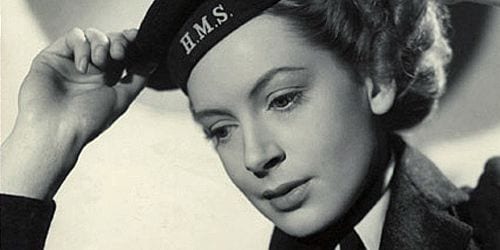
“How have military women been represented in the cinema and subsequently in television” is the question Yvonne Tasker explores in Soldiers’ Stories: Military Women in Cinema and Television Since World War II.
It is, perhaps, a deceptively simple question for an amazingly complicated book that looks at a wide range of visual images (from both the US and Britain) including films, television shows, advertisements, and recruitment posters.
Tasker starts in the ’40s, and no image (still or moving) is unworthy of (or safe from) analysis—from campy comedies and recruiting posters to more dramatic films, Tasker studies them all, and her conclusions, while somewhat disheartening at times, are always thought provoking.
Tasker details how World War II recruitment posters bragged “Don’t miss your great opportunity…the Navy needs you in the WAVES”. But she also notes promotional materials were careful not to promise recruits too much and therefore used language like: “the recruit ‘may be assigned to an exciting, thrilling job’”.
Taking her analysis one step further, Tasker describes how many of these posters showed women as both independent and childlike. An ATS (Auxiliary Territorial Service) poster proclaimed “ATS CARRY THE MESSAGES. The motor cyclist messenger, roaring across country from Headquarters to scattered units is now an ATS girl.” Tasker’s response:
A rhetoric of girlishness works to mediate the shock of the military woman in such imagery, both infantilizing her and emphasizing her status as not yet a woman. She is not neglecting the responsibilities of adult womanhood, but rather channeling her youthful energies into the (temporary) service of the nation. Such images were produced by teams mindful of a contemporary context in which many responded to the idea of women’s military service with skepticism and even hostility.
From posters to comedies, dramas, and musicals—women were “a provocative presence”, supportive “girls”, and “invisible soldiers”. Sometimes women were also heroes as one of the taglines for So Proudly We Hail (1943) confirms: “HEROINES FIRST….BUT WOMEN ALWAYS…even under fire!” Tasker quickly notes that “It is telling how explicitly the audience is reassured here that the heroic military woman retains her female identity”.
Tasker ends the first chapter with one of her many conclusions: “Both recruitment materials and feature films also speak to contemporary concerns that military service might trouble gender norms, rendering women masculine or mannish or facilitating inappropriate sexual possibilities (promiscuity or lesbianism)”. And perhaps surprisingly, this never really changes.
Jumping forward, Tasker opens the chapter on M*A*S*H and Private Benjamin as she does many others, by blending historical information (such as the dates women first entered the service academies) with cultural criticism. But it’s the cultural criticism that stands out. We may now (in the book) be in the ’70s and’ 80s with the sexual revolution, the women’s movement, and the first major female American vice presidential candidate, but “The stereotypes developed 1950s and 1960s, from the military woman as compelling sign of strength and independence to her iteration as sexy nuisance, persist in this period. So too does the narrative concern with her impact on military men”.
Tasker reveals several character issues and plot lines involving Major Margaret “Hot Lips” O’Houlihan (including how she received the nickname) and shows a still from the television series where “Major Houlihan (Loretta Swit) gleefully wields a whip, a gift from her fiancé, in comic rendition of the woman on top”.
The discussion of Private Benjamin is even more disturbing. Tasker describes a scene from the end of the film where Judy Benjamin is too frightened to jump from a plane:
She finally overcomes her fear and jumps only when [Colonel] Thornbush reveals his passion for her, declaring ‘There are other ways in which you can serve’. Sexual harassment, even the threat of rape, is played for comedy here, underlining both the untrustworthiness for officers (a generic staple) and the danger of stepping too far outside gender norms.
And the gender stereotypes and concerns don’t end in the ’70s and ’80s. Tasker goes on to explore the likes of A Few Good Men, JAG, The General’s Daughter, and Stealth.
All the chapters are impeccably researched and meticulously detailed, but it’s Tasker’s attention to small particulars, the kind many casual observers might miss (such as an offhand reference to a beauty parlor or the importance of costumes in “transformation narratives”), and the complicated conclusions she draws, even when the films (or television shows) seem superficial on the surface, that really make the text.
Also beneficial are the number of images. Statements like “In Marine Raiders (1944) military women are pictured disrupting the frame and the expectations of male Marines” or “The muscular pilot Cassie (Raye Hollitt) represents a masculinized image of the military woman in the JAG pilot episode” are clear but become much more meaningful when partnered with an image.
A dense book, probably for somewhat serious scholars or dedicated grad students rather than the average film bluff, Soldiers’ Stories may teach more than some ever expected. Reading Tasker’s analyses of these texts could make many rethink what is considered “entertaining” at the expense of women.

![Call for Papers: All Things Reconsidered [MUSIC] May-August 2024](https://www.popmatters.com/wp-content/uploads/2024/04/all-things-reconsidered-call-music-may-2024-720x380.jpg)



